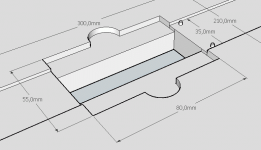miissaka
Newbie
How many here uses masking in the darkroom? I gave it a try after reading the articles in "Way Beyond Monochrome" (for example, this: http://www.darkroomagic.com/Publications/WBM/UnsharpMasking.pdf ) It is not a technique for all negatives, that's for sure. I tried using tape and a light table but for me it is tedious at best. However, the results were promising so I begun to look for more usable alternatives.
I searched the net for prices on masking kits and carriers and quite quickly decided that I'd first try to build my own. 🙂 I'm using a Beseler 45 MCX for my large format and 35mm negatives. I already have read the article by Mark Jilg and Dennis McNutt (http://web.archive.org/web/20020603051329/hps.vanguard.edu/Photo/Art1Sidebar.html - it is no longer available at the original site)
So, here's my plan roughly:
I plan to use MDF as the base material since I can work with it rather easily and it is stable. (I made a prototype negative carrier from it and I must say it has to be finished with paint and whatever in order to keep it from producing dust!) My plan is to rout tight recesses for the bottom glass, film and top glass. Then I'll install punch/registration pins to the carrier so it'll do double duty as a punch as well. I'll do a Sketchup drawing and post it here so it'll be more easy to understand.
Should I take the pins/punches from an ordinary paper punch or can I device them from somewhere else?
Any suggestions or advice is appreciated.
Mikko
I searched the net for prices on masking kits and carriers and quite quickly decided that I'd first try to build my own. 🙂 I'm using a Beseler 45 MCX for my large format and 35mm negatives. I already have read the article by Mark Jilg and Dennis McNutt (http://web.archive.org/web/20020603051329/hps.vanguard.edu/Photo/Art1Sidebar.html - it is no longer available at the original site)
So, here's my plan roughly:
I plan to use MDF as the base material since I can work with it rather easily and it is stable. (I made a prototype negative carrier from it and I must say it has to be finished with paint and whatever in order to keep it from producing dust!) My plan is to rout tight recesses for the bottom glass, film and top glass. Then I'll install punch/registration pins to the carrier so it'll do double duty as a punch as well. I'll do a Sketchup drawing and post it here so it'll be more easy to understand.
Should I take the pins/punches from an ordinary paper punch or can I device them from somewhere else?
Any suggestions or advice is appreciated.
Mikko


